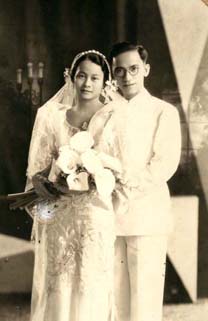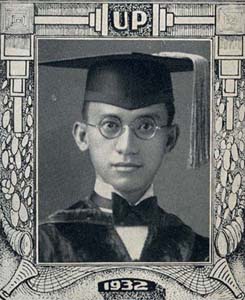The fourth child of Jose Villafuerte Lahoz and Maximina Soliven Torrano, Manuel was born on June 17, 1905. Manuel (Nolong) was 16 years old when his mother Maximina died in 1921. Whether this influenced his decision to study medicine can no longer be verified. As a child, he was considered brilliant, excelled in academics and athletics. He was into gymnastics (bars and rings), swimming, tennis, baseball and other games.
 In 1932, Manuel graduated from the UP College of Medicine. In the same class was his college sweetheart fondly called Queenie - Dra. Monica B. Laquindanum of Malolos, Bulacan. Manuel and Monica (Quening, to the family) got married soon after graduation and started their medical practice. Their first hospital was the Vigan Christian Hospital which they took over from Dr. Paul Palencia when the latter became medical director of Paracale Mining Hospital.
In 1932, Manuel graduated from the UP College of Medicine. In the same class was his college sweetheart fondly called Queenie - Dra. Monica B. Laquindanum of Malolos, Bulacan. Manuel and Monica (Quening, to the family) got married soon after graduation and started their medical practice. Their first hospital was the Vigan Christian Hospital which they took over from Dr. Paul Palencia when the latter became medical director of Paracale Mining Hospital.
Tuberculosis was a prevalent illness at that time and unfortunately Quening contracted TB. When her condition would not improve, Nolong and Quening moved to Baguio in the hope that the milder climate would cure Quening's tuberculosis. Quening's condition would not improve so Nolong brought her to Quezon Institute (established earlier in 1938) which specialized in the care and cure of tuberculosis.
While Monica was a patient at the Quezon Institute she learned of an opening for a surgeon and submitted the name of her husband. After passing the competitive exams, Manuel joined the Quezon Institute where he and Monica worked at the outbreak of the second world war in 1942. Monica's condition did not improve and she died while confined at the Quezon Institute.
Benita (Titang) Lorenzo was a nurse working at Quezon Institute during the same time. After Quening died, Nolong courted Titang and after the one year grieving period, they got married even while the country was under the hold of the Japanese invaders.
After the Japanese suspected that the QI was being used to spy on their movements for the guerillas, the hospital director went into hiding and Nolong was appointed Acting Director.
Carrying the responsibility for the entire hospital meant Nolong had to take care of the patients and staff of the hospital even during the time that the patients and staff were moved to the San Juan de Dios Hospital in Intramuros. (The Japanese decided to take over the grounds and newer facilities of the Quezon Institute as their hospital.) Nolong and Titang moved to the house of his older brother, Jose, in 617 C. Ayala St in Singalong to be closer to the hospital. Nolong bought a bicycle and he and Titang would commute to work on the bicycle.
In January, 1945, the American forces landed in Lingayen Gulf in Pangasinan and were given orders to proceed to Manila and retake Manila at all costs. From a beach head in Leyte where General Douglas MacArthur landed earlier, the American naval forces also made their way towards Manila by way of Sangley Point in Cavite. This put considerable pressure on the Japanese forces well entrenched in Intramuros. Rather than surrender in shame, they went on the offensive with wanton killing and destruction of the city which was once the Pearl of the Orient Seas.
Nolong and Titang knew the risks. They could have joined the many who left Manila for the safety of the provinces. However, true to his reputation as (contained in THE PHILIPPINENSIAN 1932 University of the Philippines Annual) "A rare specimen of diligence, tenacity and perseverance, in whatever pursuit he is in", Nolong decided to risk his and Titang's life to care for their patients at the hospital. As the situation worsened, they could no longer pedal home to C. Ayala and instead stayed at the staff quarters in the hospital.
In the early morning of February 17, 1945, Nolong was roused from his sleep in the hospital when the Japanese ordered all the men in the San Juan de Dios Hospital to assemble beside the nearby church where they were killed at the end of the Japanese bayonets. It has been told that before the Japanese soldier thrust his bayonet into Nolong, he asked for Nolong's forgiveness for what he was about to do.
Titang luckily was spared from the carnage and she was able to bury Nolong and years later recover his bones and sometime in the 1960's brought the bones home to Vigan so a proper burial could be given to him at the family mausoleum.
In recognition for his supreme sacrifice which resulted in his death at a young age, Dr. Manuel T. Lahoz was awarded posthumously a Plaque of Special Award by the Philippine Tuberculosis Society during their Golden (50th) Jubilee on August 12, 1960. The citation states:
"FOR UNSWERVING DEVOTION TO THE WELFARE OF HELPLESS QUEZON INSTITUTE PATIENTS DURING THE BATTLE OF LIBERATION, CONTEMPTUOUS OF HIS PERSONAL SAFETY; FOR THE SUPREME SACRIFICE THAT FATE DECREED WHILE IN THE MIDST OF UNIQUE HEROISM--BEYOND THE CALL OF DUTY--AND FOR STICKING TO HIS POST, HAVING BEEN DESIGNATED ACTING DIRECTOR OF QUEZON INSTITUTE, AT ALL COST FOR ALL TO SEE."
Nolong will forever be held in high esteem and high regard by the family he left behind. His name has been passed on to three members of the next generation of the Lahoz Clan: Manuel Lahoz Tongson, co-incidentally the fourth child of Nolong's younger sister Rosario and Julio Tongson; Manuel Colet Lahoz, son of Gaudencio, Jr. and Angelita C. Lahoz; and Manuel Ruffy Lahoz, son of Bernardo and Carmen R. Lahoz.
On the encouragement of their father, Jose Sr., his brother Antonio took up a career in surgery to continue whatever legacy Manuel left in the field of Medicine.
Today, while there were two doctors in his generation belonging to their family branch, there are now thirteen doctors (descendants and in-laws) in succeeding generations.
On this, what would have been his 100
 In 1932, Manuel graduated from the UP College of Medicine. In the same class was his college sweetheart fondly called Queenie - Dra. Monica B. Laquindanum of Malolos, Bulacan. Manuel and Monica (Quening, to the family) got married soon after graduation and started their medical practice. Their first hospital was the Vigan Christian Hospital which they took over from Dr. Paul Palencia when the latter became medical director of Paracale Mining Hospital.
In 1932, Manuel graduated from the UP College of Medicine. In the same class was his college sweetheart fondly called Queenie - Dra. Monica B. Laquindanum of Malolos, Bulacan. Manuel and Monica (Quening, to the family) got married soon after graduation and started their medical practice. Their first hospital was the Vigan Christian Hospital which they took over from Dr. Paul Palencia when the latter became medical director of Paracale Mining Hospital. The American Heritage Dictionary defines a hero as: "A person noted for feats of courage or nobility of purpose, especially one who has risked or sacrificed his or her life: soldiers and nurses who were heroes in an unpopular war."
The American Heritage Dictionary defines a hero as: "A person noted for feats of courage or nobility of purpose, especially one who has risked or sacrificed his or her life: soldiers and nurses who were heroes in an unpopular war."